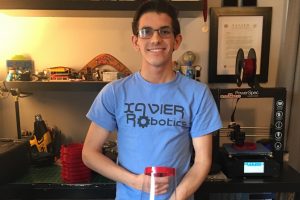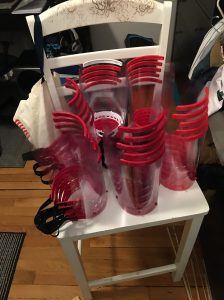
Like many, mechanical engineering student Esteban Rivera is adjusting to a new reality caused by the COVID-19 pandemic: finishing his first year of college at home. But in addition to finishing his coursework remotely, Rivera has found another means to put his engineering skills to good use while away from campus.
From his home in New Rochelle, New York, Rivera has joined a worldwide initiative of volunteers who are using 3D printing techniques to meet an urgent need for protective equipment and medical devices. He is using his own 3D printer to produce plastic face shields that are helping healthcare professionals and seniors during the pandemic.
Face shields and masks are part of an arsenal of personal protective equipment (PPE) worn by healthcare workers, such as doctors and nurses, to protect their faces from airborne particles and from liquid contaminating the face, according to the U.S. Food & Drug Administration.
Experts say that PPE can help slow the spread of coronavirus, but current supplies can’t meet the growing demand. Face shields are a safe item to print at home because they can be worn alone or in conjunction with other PPE, and – if sanitized properly – can be reused.
Rivera said he was spurred into action when he heard about the shortage of face shields for healthcare facilities and senior homes in his native New York, a state hit hard by coronavirus cases.

3d printed face shields
“I’m trying to donate to organizations that have high demand and cannot get PPE, which is why I have mostly donated the shields to senior homes so far. But my goal is to donate to as many places as possible that need them,” says Rivera.
So far, Rivera has printed and donated more than 140 masks and has plans to produce more, with the help of his brother and father. He’s been donating many of the shields through family members who work in the healthcare field, or sending them directly to service organizations he has worked with in the past.
To print the shields, Rivera relies on the PRUSA open-source design that is being widely used by the 3D printing community during the pandemic. He can print at least 10 a day now, after upgrading his printer and cutting the print time for each mask down to an hour. After printing, Rivera must treat the prints to remove any stringing or burrs from them, so they are safe and comfortable to wear. Finally, he assembles each mask – visor, clear plastic shield, and elastic band – before sending them out for donation.
“It’s been a lot of work preparing the masks, but I’m thankful for the opportunity to help during this crisis, by doing engineering work that I enjoy. In times like this, I’m proud to be a Xavier High School alumnus and grateful to live out our mission of being ‘Men for Others’ here in the Hopkins community,” says Rivera.